The workshop will be closed tomorrow morning between 09.30 and 11.00 for planning inductions. Normal opening times resume from 11.00.
Apologies for any inconvenience caused and late notice.

The workshop will be closed tomorrow morning between 09.30 and 11.00 for planning inductions. Normal opening times resume from 11.00.
Apologies for any inconvenience caused and late notice.
We were recently visited by the two Modelmakers from a company called Maquettica based in Riga, Latvia. Janis Strazdins, CEO and Lelde Strazdiņa senior Modelmaker at the company have recently travelled across the UK researching the commercial role of Architectural Modelmaking. As part of their trip they stopped by to view our exhibition and we gave them a tour of our facility.
As we are always interested to understand how others work in the field of modelmaking we asked them to tell us their story.
As modelmakers we came intuitively.Janis made his first architectural model already at the age of 14, it was his parents house at country side and he did it just for fun.
 We both have an architectural education, but in Latvia there are no special programs or
studies for architectural modelmaking. At the university here the architectural models are just a need which you add to your project. We spent much more time than other students on model making because we enjoyed the process a lot and gradually we started to be more and more interested in this speciality.
Logically we got our first orders, sometimes from other students, and very quickly our activity turned professional. Since then we still grow and develop our studio by digging and searching for the most appropriate materials, tools and equipment which allows us to work creatively, accurately and in high quality.
Our main occupation is realistic architectural models for marketing and presentation purposes and product prototype making, but unfortunately in our country the market is too small to survive only as modelmaking studio so we have added some more products and services that we are able to make with the equipment that we have for modelmaking.
We separated those other products from architectural models and put them all to ‘Ouzel‘, a branch off company.
Ouzel is our idea visualization studio which provides design objects, museum exposition and unique interior elements, such as decorations, furniture elements, lighting objects, etc.
Generally our clients are real estate developers, architects, also architecture students and individuals.In some cases museums, specific companies (for example factories or adventure parks).
Architects usually need the models for presentation, usually when they participate in competitions. Real estate developers use very realistic scale models as a marketing instrument. They are made very precisely from technical drawings.Adventure parks, they also need realistic models, but the main purpose is to make them attractive.To receive all necessary information for model making we have created on-line inquiry form on our website, but mainly for a proposal it is enough to have territory plan, building plan, facades and some visualizations.
The B.15:45 exhibition we visited is one step closer to explaining to society why modelmaking is worth the effort and also what it takes (a lot of time, patience, enthusiasm, spatial and constructive perception, knowledges, materials, equipment, ..) to make an architectural model that works.
Your workshop is Latvian architecture students dream to have at University. The variety of materials, tools, equipment and possibility to ask enthusiastic professors for advice – these opportunities allow a student to work at their project more creatively, confidentlyand whilst having more fun. A student’s activity in the workshop lets them feel the physical interaction – materials, shapes, light, .. which is impossible to get from a computer.
You can find out more about Maquettica on their website here. http://www.maquettica.eu/
Just a quick message to everyone who came to speak and helped us make yesterday’s symposium event possible. We thoroughly enjoyed the day and everyone was extremely positive about our approach to modelmaking and it’s future in architecture.
In all we had 90+ registered guests from a variety of backgrounds all with a shared interest of the subject. Thank you for all your support, it means a lot.
The event was full of interesting presentations and discussions that we are hopeful will lead to further expansion and future events orientated around the subject of how we use models in architecture.
We will be uploading footage of the event for those who missed it in the coming months so stay tuned for those.
Many thanks to all again – we can’t thank you enough!
Scott and Jim
We are happy to announce the following guide to our Symposium ‘Modelmaking in the Digital Age‘ taking place this Monday 9th March.
These time serve as a guide and we will endeavour to stick to them but expect some under and overrun due to the amount of material we are trying to fit into the day.
Registration is now for the symposium is now closed.
MSA Praxis student Paul Thornber produced this ‘rough and ready’ sketch model in just 6 hours and cost him the grand total of £0! Made entirely from waste scraps this model clearly conveys the structural arrangement of Pauls project without need for expense or time consuming methods. More importantly the process of planning, marking out and making the model has been a learning experience as Paul describes below:
“I intend to use the model to explore how structural decisions affect spatial conditions.
The model was used to help make decisions, in the development stages, regarding structure through experimentation.I was able to economise on structure through building at scale and assembling the model by hand.It also helped me prove that I understood how the buildings structural strategy worked.
Through making this model I have learnt how to form and develop the plan of a building through a process of experimentation in both 2D and 3D.
Quickly switching from plan to section to model and back again helped me rapidly develop ideas that worked both on paper and in 3D.
This model gave me an insight into the next stage of model making for the final output of the next project. I will now know what works and what doesn’t before starting a more refined version of this model.”
This is how the medium of modelmaking should be used in my opinion. By employing making as a tool to develop your ideas you are opening up yourself to technical processes, material constraints and lessons that can be directly transferred to your design decisions when working at to 1:1 scale design.
You can see more of Pauls work here:Â http://www.paulthornber.com/
Scott
As part of his ‘Sensory Markets’ project Alex Pavlides has created a 1:1 section of brick wall to display a possible facade detail providing an organic coat to existing brick walls in Manchester. 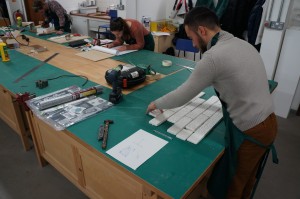 The approach to recreating the brick wall was much like that of Polys Christofi’s project last year but focussed on a much smaller area for the detail. Bricks were made using plaster casts from vac-formed moulds before being painted to resemble red brick and then pointed like a full scale wall.
The approach to recreating the brick wall was much like that of Polys Christofi’s project last year but focussed on a much smaller area for the detail. Bricks were made using plaster casts from vac-formed moulds before being painted to resemble red brick and then pointed like a full scale wall. 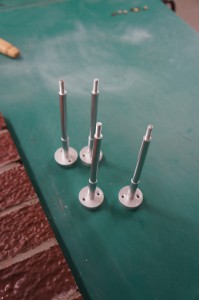 Details of the intervention were made up using laser cut acrylic bases, abs tubing and threaded rob before being sprayed silver to represent the intended metal finish of the mountings. The detail mounts were then fixed to the ‘wall’ and mesh was added to the ends creating an elevated platform to encourage plant growth in front of the wall. The mesh was then secured using washers and bolts.
Details of the intervention were made up using laser cut acrylic bases, abs tubing and threaded rob before being sprayed silver to represent the intended metal finish of the mountings. The detail mounts were then fixed to the ‘wall’ and mesh was added to the ends creating an elevated platform to encourage plant growth in front of the wall. The mesh was then secured using washers and bolts. 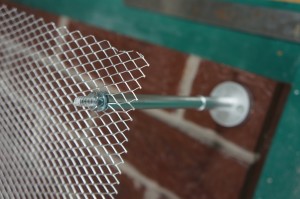 Alex describes his approach to the project:
Alex describes his approach to the project:
“I’ve tried [to] introduce an intervention that makes the alleys memorable to the people by making the alleys acting as “landmarks” in the city. The intervention is about applying moss on different surfaces in the alleyways and create architecture from moss. I designed an external skin of the brick walls made of steel wire mesh and the moss will be applied on the mesh at different points of the city. “
 Alex is currently working on getting moss to grow on the mesh to be displayed later in the year and we look forward to seeing the results! We will post an update of how he progresses.
Alex is currently working on getting moss to grow on the mesh to be displayed later in the year and we look forward to seeing the results! We will post an update of how he progresses.
Scott
3rd year Coexistence in Theory has been focussing on a stalled site located next to the Mancunian way in Manchester. The group will use this abandoned infrastructure to propose new interventions that will bridge the site bringing in to back into functional use.

 The group decided to represent a large portion of the Mancunian way which runs through the city along with building massing and defined roadways across the site. This was done by overlaying grey card board pieces to act as raised pavements creating contrast with the light coloured plywood base below which provides the road areas.
The group decided to represent a large portion of the Mancunian way which runs through the city along with building massing and defined roadways across the site. This was done by overlaying grey card board pieces to act as raised pavements creating contrast with the light coloured plywood base below which provides the road areas.
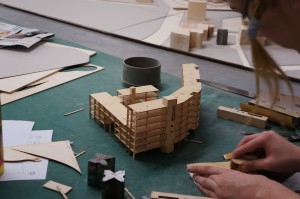
 The stalled site in question is represented in more detail due to its importance and comparative skeletal appearance to the rest of the buildings in the area. This was made using laser cut ply whilst the main massing of the rest of the model is made us of blocks of pine cut and sanded to shape.
The stalled site in question is represented in more detail due to its importance and comparative skeletal appearance to the rest of the buildings in the area. This was made using laser cut ply whilst the main massing of the rest of the model is made us of blocks of pine cut and sanded to shape.
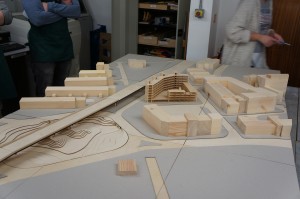
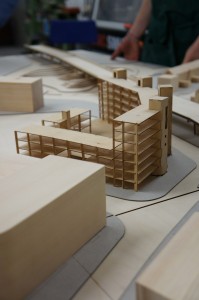 Group member Georgina Erotokritou described why the group are producing the model for their projects:
Group member Georgina Erotokritou described why the group are producing the model for their projects:
“It’s the easiest and most understandable way to explain ideas, space and arrangements in 3D space. Because this model covers a wider context it is easier for the viewer to see the entire picture and see how our buildings connect to the site.”Â
The model is now being used as a stage to present the groups ideas as they develop throughout the year.
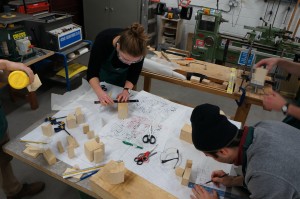 This 6th year group project took time to think about their options with this model of a site in Granada, Spain. Initially they had thought about producing their model using the laser cut ‘Stacking’ method which has become something of an epidemic of late in the workshop. I’ll be writing a piece on why we’d advise you steer clear of stacking components soon.
This 6th year group project took time to think about their options with this model of a site in Granada, Spain. Initially they had thought about producing their model using the laser cut ‘Stacking’ method which has become something of an epidemic of late in the workshop. I’ll be writing a piece on why we’d advise you steer clear of stacking components soon.
Thankfully with some deliberation it was decided that a much more effective and exploratory process of could take place saving a lot of material and laser cutting as well as yearning an effective learning curve in model making.
Taking some inspiration from our B.15:45 display the group decided to make their site context using Jelutong Block and offcuts. The only use of laser cutting was in the engraving of the base plan on 6mm Plywood. As with many site context models, this one will serve as a working model that will be used by individuals to display their work throughout the development of their ideas this year. With this in mind the consistent use of jelutong as a block massing material is quite suited and is aesthetically quite nice to look at.
The group divided their site into areas with each of the 5 team members taking responsibility for the production of a given set of buildings. This way the workload was split and progress of the model can be achieved to a good standard the time managed efficiently. Rather than spending days on the laser cutter effectively pressing ‘go’ then sticking pieces of a very easy (and bland) puzzle together this group have used their workshop time to improve their making skills and understanding of the form of their site by thinking about each and every building beyond its footprint shape on a Digimap file.
This process is much more useful to learning than simply laser cutting material for the sake of it I think they would all agree.
Scott
This project looks at a site sandwiched between exiting buildings and natural boundaries in Stockport centre. As with most of the projects I have seen Fin work on it’s great to see someone using a variety of media on their desk to inform the decisions in making and in turn use the results to influence their ideas.
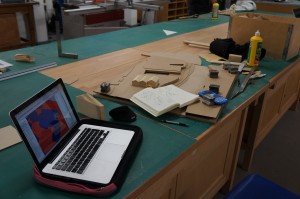 As the site includes several large tower blocks it was decided to create the masses as hollow boxes to both save on material and weight of the completed model. The box sections seen here were carefully made up from planes of material – most of it scraps from other projects.Â
As the site includes several large tower blocks it was decided to create the masses as hollow boxes to both save on material and weight of the completed model. The box sections seen here were carefully made up from planes of material – most of it scraps from other projects. 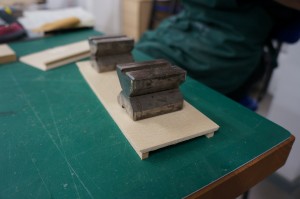
Once again being concious of material use, Fin designed his contour base to be laser cut into steps with supports as opposed to entire sheets. This again saves material and overall weight. The process requires some minimal extra consideration when producing drawings but the savings are great and well worth the effort. Read more on this method of construction here.
To create the imposing and dominating viaduct feature which spans across the site Fin chose to use a solid mass created from pine. The arches were drawn out and rough cut on the bandsaw before being sanded smooth. 
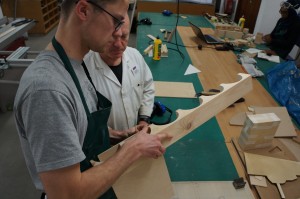 Legs for the viaduct were created as separate pieces with varied heights depending on their position across the contours. The legs were then clamped and glued over night.
Legs for the viaduct were created as separate pieces with varied heights depending on their position across the contours. The legs were then clamped and glued over night.
Finbar gave us a few words reflecting on the project so far:
‘The model has helped to negotiate a complicated landscaping condition, in that the envelope links three different levels: water, ground and the 1st floor gardens, of a proposed Waste Water Treatment Plant in Stockport city centre. The context is modelled with traditional craft methods as I feel the site has a great sense of history, including the famous Stockport Viaduct. It has helped to explore sensitive ways of repurposing existing warehouses I used Pepakura software to produce nets of meshes generated in Grasshopper for Rhinoceros, for the initial massing proposals.
The next step is to combine the spatial arrangements of the building with environmental analysis and try new massings on the same model.’
The completed model has a removable site section to allow different proposals to be inserted into context. Fin has already made several suggested forms from card as seen below. 
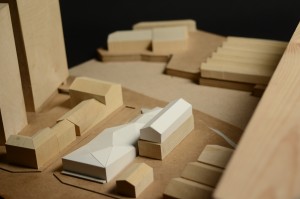

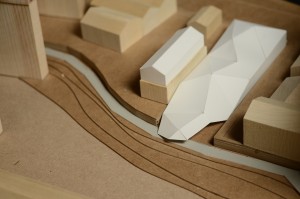
Towards the end of the first semester 5th Year Student Peter Lee was approached by The University of Manchester to design and make a large scale set piece for the student run festival, Pangaea. The event was held at the Manchester Academy and runs across many venues in Manchester. Pete described the project for us:
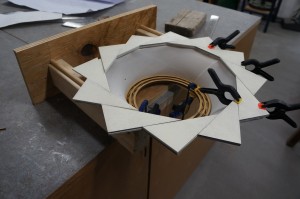 The model was made using components that would eventually come to life as large scale versions looking virtually identical. A wooden frame was used to support a focal hub and fabric was then stretched to the back of the segmented aperture-like ring at the front of the piece.
The model was made using components that would eventually come to life as large scale versions looking virtually identical. A wooden frame was used to support a focal hub and fabric was then stretched to the back of the segmented aperture-like ring at the front of the piece.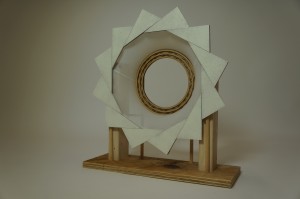 Once the design has received approval for full size production Peter went about turning the concept model into a full scale design. The triangular sections were each cut out using the larger CNC cutter at MMU before being transported across to B.15 for additional pieces to be added.
Once the design has received approval for full size production Peter went about turning the concept model into a full scale design. The triangular sections were each cut out using the larger CNC cutter at MMU before being transported across to B.15 for additional pieces to be added.
Peter describes his reasoning for using CNC cut components for the full scale prop:
Due to the obvious weight difference in the full size version of the prop each component had to be well built to avoid any accidents. Each triangular section was reinforced with pine timber baton which was glued and screwed into place.
‘Good communication with other parties was also key as the success of the project was highly dependent on fittings in the Academy and the synchronisation with projections. Resolving issues far in advance meant the on-site build and event itself ran smoothly.’.
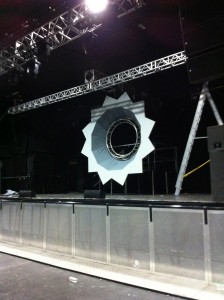 In place at the venue, the stage prop served as the focal point for the nights performers and was lit by constantly changing projections and light displays. The image below shows the piece on stage before the event began. The image below show the finished piece during the live event.
In place at the venue, the stage prop served as the focal point for the nights performers and was lit by constantly changing projections and light displays. The image below shows the piece on stage before the event began. The image below show the finished piece during the live event.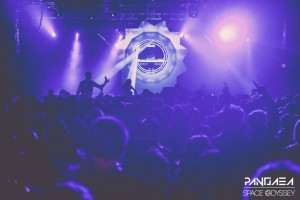
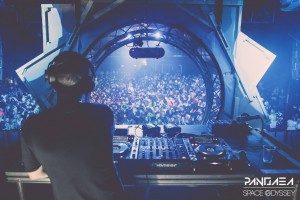
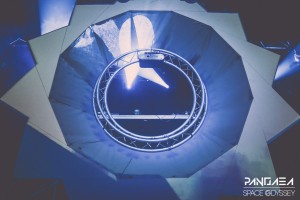 Comparing Peter’s prototype to the completed piece shows very little structural difference and is yet another example of how a test model can serve to prove a design idea. Both the development and final versions of the project will make great additions to Peter’s portfolio with the two conveying his design thought and testing processes to a potential client or employer. You can see more of his work here.
Comparing Peter’s prototype to the completed piece shows very little structural difference and is yet another example of how a test model can serve to prove a design idea. Both the development and final versions of the project will make great additions to Peter’s portfolio with the two conveying his design thought and testing processes to a potential client or employer. You can see more of his work here.